As summer approaches, experts at the Gilded Age estate reveal how they keep the flowerbeds flourishing
Words by DAVID NASH
Photography by ALANNA HALE
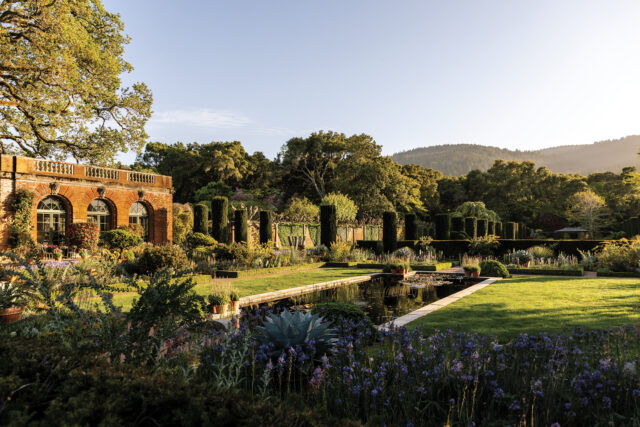
Like one of the spectacular settings in the celebrated series Downton Abbey, the century-old Filoli estate 25 miles south of San Francisco is a bastion of post–Gilded Age glory in the U.S. But the neo-Georgian style 56-room mansion — and its immaculately maintained gardens, orchards, and woodlands — is more than a 654-acre vestige of the past; it’s also an evolving story. And like an expansive golden-era manor, it takes a full-time team of skilled artisans to keep Filoli looking formidable. A horticulture team of 17 has been transitioning the gardens from spring in preparation for the busy summer season — 600,000 visitors are expected this year. This monumental task involves removing and composting spent bulbs, planting begonias and other perennials, moving pots into and out of storage, calculating water usage, clearing hiking trails, and managing critters that can upend the landscape.
Filoli operates as a private nonprofit organization, and in August it celebrates 50 years since the National Trust for Historic Preservation acquired it. The home’s gardens are widely lauded among the country’s best, with British garden designer Penelope Hobhouse calling it “one of the most beautiful formal gardens in America.” But it takes much more than a green thumb to maintain the 16 acres of “garden rooms,” greenhouse operations, and natural lands.
“I tell people it’s like running a city,” says Kara Newport, Filoli’s president and CEO. “A few years ago, we developed a comprehensive site plan and really looked at what the future holds for us and what the opportunities are. What we heard from our community — and those in the national gardens and museums world — is that we have such a unique positioning because, yes, we’re a historic house with a collection and we’re a formal garden, but we also have nature and agriculture.”
“I tell people it’s like running a city.”
KARA NEWPORT, PRESIDENT AND CEO

The bucolic Woodside country house was designed by San Francisco architect Willis Polk and built for Spring Valley Water Company president William Bowers Bourn II, who moved there with his wife, Agnes, in 1917. Heir to the Empire Mine company (and the fortune made by his father), Bourn also served as director of the San Francisco Gas Company, was an investor in Napa Valley’s Greystone Cellars (the state’s largest wine cellar before the turn of the 20th century and the first to operate by electricity), and led the merger of electricity and gas supply in San Francisco to form what would later become the Pacific Gas and Electric Company. Filoli, an acronym derived from the first two letters of the key words from his credo, “Fight for a just cause; love your fellow man; live a good life,” would remain the Bourns’ favored residence until their deaths in 1936. The next year, the estate was sold to Matson (the shipping company) heiress Lurline Matson Roth and her husband, William P. Roth, who expanded its Isabella Worn–designed gardens and added the Pool Pavilion — with Worn’s input, so it fit into the garden’s original scheme. Lurline donated the estate to the National Trust in 1975.
That colorfully lush blueprint, brought to life in 1929 after nearly a decade of construction and planning, includes olive, apple, and pear orchards and an array of seamlessly interconnected (but distinct) gardens: the Sunken Garden, with blue penstemons, prickly pear cactus, and Color Guard yucca; the Rose Garden, where fragrant specimens like Carding Mill, Just Joey, and Sally Holmes delight the senses; the Woodland Garden, with many shades of green among the perennials, shrubs, and trees; and the Walled Garden, with its smaller Chartres Cathedral Garden, a four-quadrant bed with pink, rose, and white Bada Boom begonias.
“The beds here were designed after the famous [12th-century Tree of Jesse] stained glass window at Chartres Cathedral just outside Paris,” says Jim Salyards, a 30-year Filoli veteran and the associate director of horticulture initiatives. “And it matches pretty well — for summer we’re planting three different types of begonias to highlight the stained glass effect.” Elsewhere, zinnia, cuphea, and special Megawatt Rose Bronze Leaf begonias will fill seven beds beyond the southern walled garden, and key pollinator beds get a refresh with additional pollinator-friendly plants that attract bees, beetles, butterflies, and birds. (For spring the beds were planted with purple and blue violas and pink and purple foxgloves.) “I’ve done the design of the garden for the past 14 years, and we want to make them different each year with new plants and new ways of laying things out,” Salyards says.
“The beds here were designed after a famous stained glass window outside of Paris.”
JIM SALYARDS

There are also some crowd-pleasing stalwarts dating back at least a century, including a monumental pair of Hinoki cypress. “These are two of our most special trees,” Salyards says. “They were part of the Japanese Pavilion at the 1915 Panama-Pacific [International] Exposition in San Francisco, and subsequently gifted to William Bourn, who was a silent contributor to the exposition.” Another prized specimen, a Camperdown elm, is Salyards’s favorite. “It’s a weeping form of an elm that’s native to a lot of places in Europe. It was found at an estate in Scotland as a tree, planted from seed, that lolled along the ground, but the person who discovered it figured out that if it was grafted up high it would become this big, beautiful umbrella.” In the spring, the weeping branches are ripe with flowers that give way in summer to a beautiful chartreuse canopy of leaves. “It’s a cool tree to sit under in the summer with its beautiful architecture and funky angles,” he says.
Among those on the team that cares for the trees, gardens, and natural lands is horticulturist Taylor Thorson, whose duties include weeding, watering, and hand pruning. “Working here, you really become in tune with the seasons,” she says. “While there’s a multilevel plan and tasks you know need to get done each week, things pop up and your plans can go sideways.” Some of those unexpected things literally pop up, like moles, voles, and gophers, which can create one-foot-wide openings with five-foot-long networks beneath. “Those burrowers that push up mounds and eat the fruit [growing on the property] are pretty standard, but recently we’ve had a huge uptick in ground squirrels,” Thorson says. Although the species is native, their population has exploded. “I think the problem is ecological,” she says. “Something isn’t eating them, so we’re exploring why that secondary predator isn’t around. We know we have a mountain lion roaming — which is an apex predator — so we imagine it’s pushing out the coyotes, foxes, or bobcats that would be managing the squirrels.” The team’s conundrum is how to restore balance. Potential solutions include owl boxes and creating alternate habitats to dissuade the squirrels from burrowing. “You fill the holes, but they don’t have a problem moving back in,” Thorson says. “As you can imagine, for a formal garden it’s not the look we want.”
Given that California summers have become drier and hotter because of climate change, keeping the gardens green is an arduous balancing act. “We have a lot of lawn, and it tells you if it’s dry — it consumes your summer, and you think about water the whole time,” Thorson says. As Newport notes, “Fire and water are big topics [for us], along with impacts of climate overall.” In the summer of 2022, Filoli explored the region’s water history with Blue Gold: The Power and Privilege of Water, an exhibition designed to share its conservation efforts and concerns for the future.
“Two of our most special trees were part of the Japanese Pavilion at the 1915 Pan-Pacific Expo.”
JIM SALYARDS
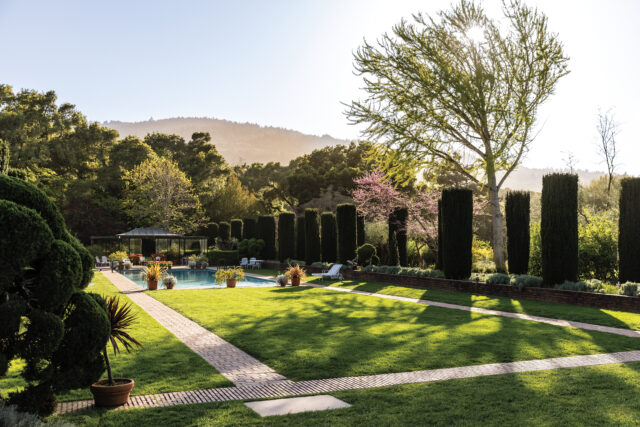
Then there’s the Filoli nature preserve, which lies beyond the box hedges and rose beds. It houses five ecosystems, including chaparral, riparian, redwood stands, and oak-madrone forests, in addition to natural springs, creeks, and cultivated grasslands. Although it’s part of the estate that sees frequent hikers along its mile-long California Trail and half-mile Spring Creek Trail, until now it has been a relatively untapped resource. “As part of our natural lands expansion, the idea is, in the next couple of years, to add three to five more miles of trails,” says Ian Walsh, natural lands and trails manager at Filoli. “There’s a lot of opportunity for cool stuff that nobody has ever seen, from [new] viewpoints to potential canopy walks among our more mature redwoods.” As part of that plan, on June 7, the estate is opening Trolls: Save the Humans, an exhibition of artist Thomas Dambo’s folklore-inspired troll sculptures that will dot the Natural Lands. “In many ways, the trolls are our ambassadors introducing the nature preserves,” Newport says. “Most people who’ve come here for years don’t even know they can get back there.”
Campaigns like this are important for Filoli, which isn’t wholly sustained by donations, endowments, or government support — all of which have inherent risk. “We’re an incredibly unusual nonprofit in that we’re [operating on] 92 percent earned income,” Newport says. “We really depend on ticket sales, membership, and programs.” The contributed income that makes up the remaining 8 percent funds projects and reinvestment, like the overhaul of the working vegetable garden and the construction of a terrace on the north side of the house — both of which were 100 percent donor funded. Says Newport, “Our plan, though, is to build out to see one million [visitors] annually, but that’s all dependent on [raising funds] for our expansion out into nature.” filoli.org.
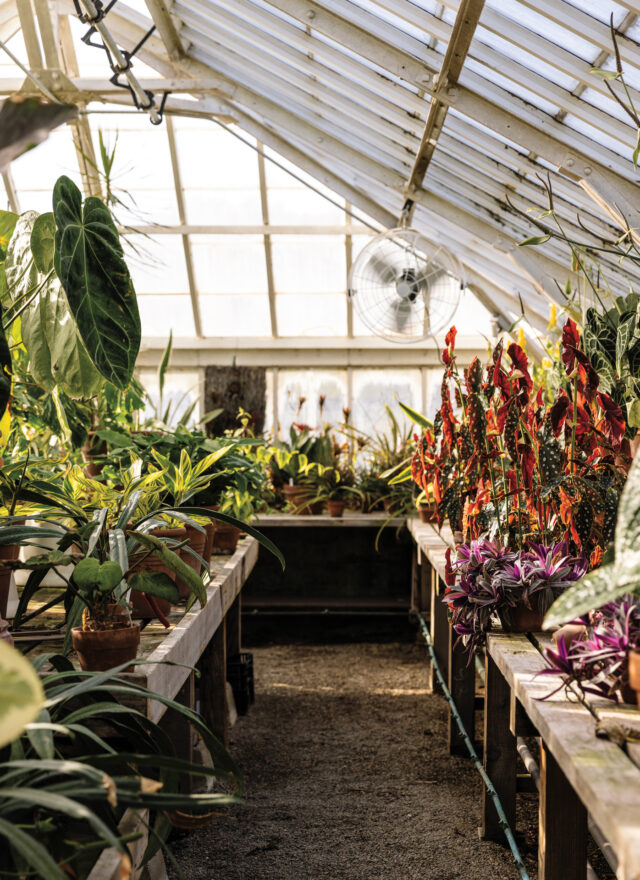


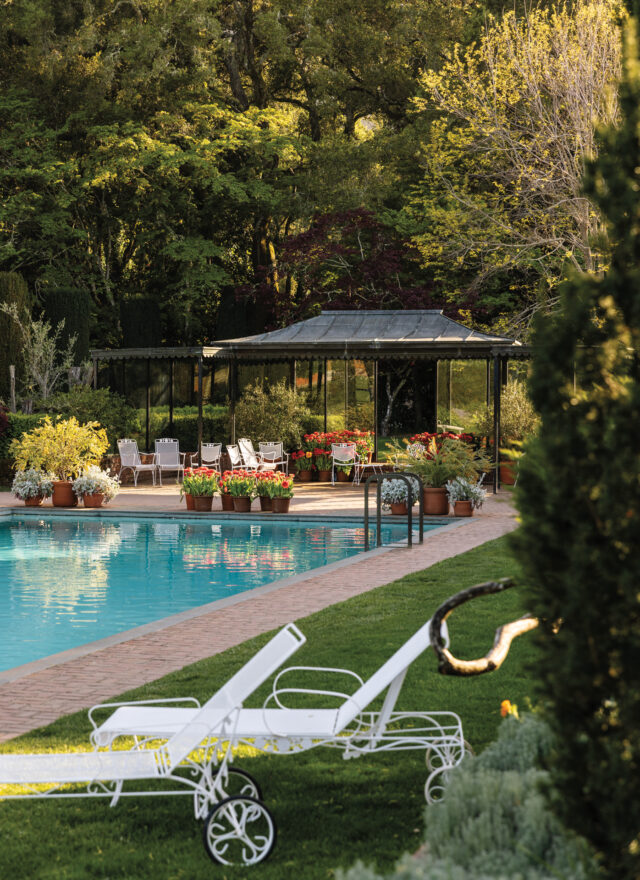
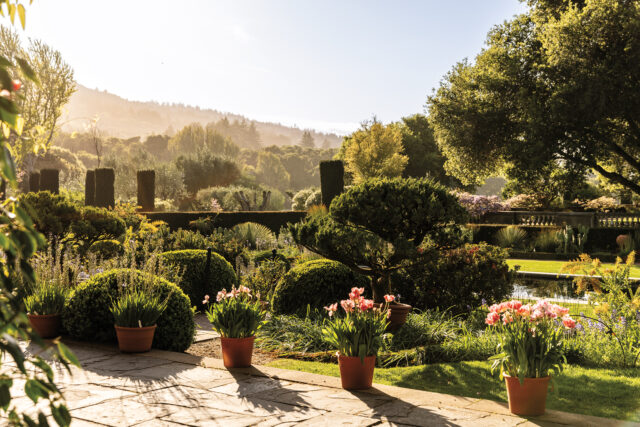

This story originally appeared in the Summer 2025 issue of C Magazine.
Discover more DESIGN news.
See the story in our digital edition




